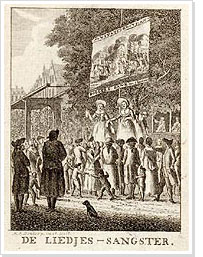Broadside ballads > Songs in markets and squares
 Since the sixteenth century, professional singers and broadside vendors have worked in the Netherlands, earning their money by singing and vending songs. It was a difficult trade, on the fringes of society. The materials they used (printed paper and illustrations) were cheap, and editions were limited.
Since the sixteenth century, professional singers and broadside vendors have worked in the Netherlands, earning their money by singing and vending songs. It was a difficult trade, on the fringes of society. The materials they used (printed paper and illustrations) were cheap, and editions were limited.
Vendors generally peddled their wares along the streets. Favourite spots were those where plenty of people would come: markets, fairgrounds, bridges, squares, street corners. Many songs begin with standard verses like 'Who wants to hear a new song?'
In the café-chantants and cabarets that appeared throughout the nineteenth century, certain types of song were performed. The appearance of the gramophone and the radio introduced a new kind of song to the market: light music. This is accompanied by a new kind of broadside, using more expensive printing techniques, with more or bigger illustrations, and musical notation. These songs were made available to the public by music shops.
The cheap begging-sheets that appeared in the twentieth century were sold on the streets, but not by professional singers or sheet vendors. 'The unemployed and other needy persons' sold the sheets from door to door in an attempt to secure an income for themselves.
